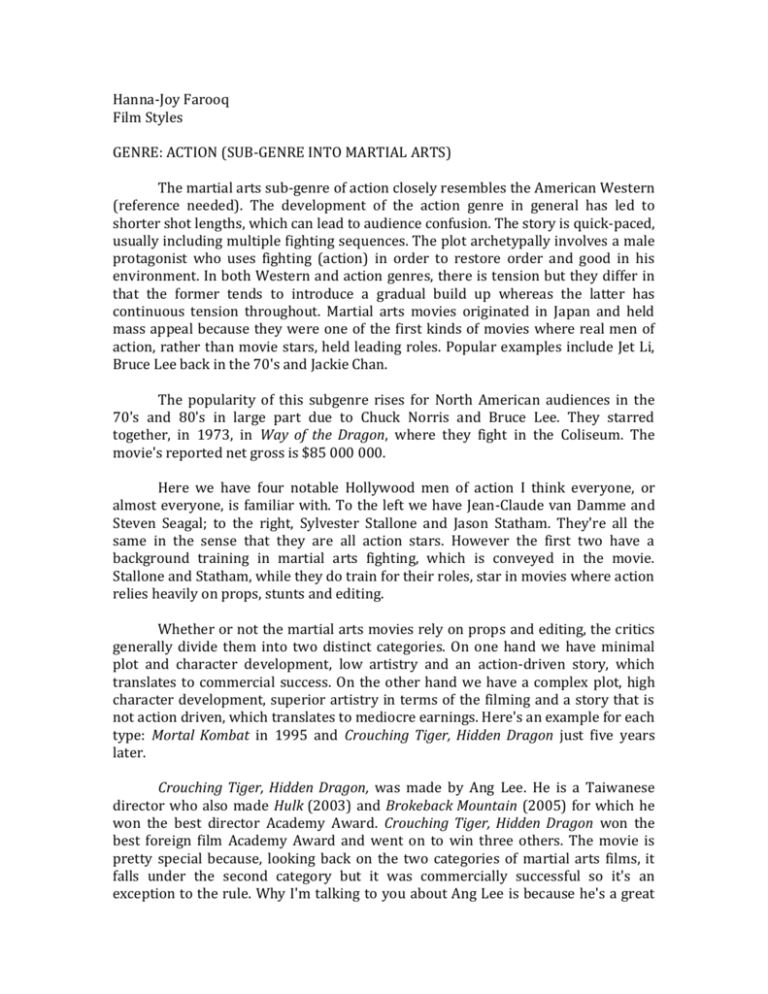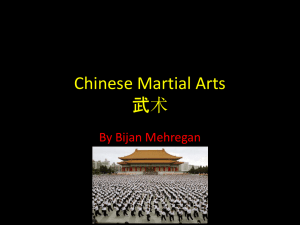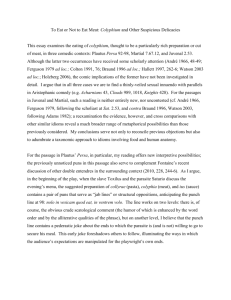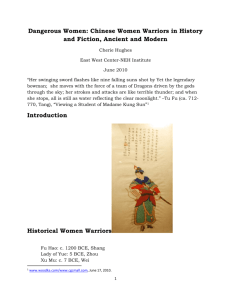development of martial arts
advertisement

Hanna-Joy Farooq Film Styles GENRE: ACTION (SUB-GENRE INTO MARTIAL ARTS) The martial arts sub-genre of action closely resembles the American Western (reference needed). The development of the action genre in general has led to shorter shot lengths, which can lead to audience confusion. The story is quick-paced, usually including multiple fighting sequences. The plot archetypally involves a male protagonist who uses fighting (action) in order to restore order and good in his environment. In both Western and action genres, there is tension but they differ in that the former tends to introduce a gradual build up whereas the latter has continuous tension throughout. Martial arts movies originated in Japan and held mass appeal because they were one of the first kinds of movies where real men of action, rather than movie stars, held leading roles. Popular examples include Jet Li, Bruce Lee back in the 70's and Jackie Chan. The popularity of this subgenre rises for North American audiences in the 70's and 80's in large part due to Chuck Norris and Bruce Lee. They starred together, in 1973, in Way of the Dragon, where they fight in the Coliseum. The movie's reported net gross is $85 000 000. Here we have four notable Hollywood men of action I think everyone, or almost everyone, is familiar with. To the left we have Jean-Claude van Damme and Steven Seagal; to the right, Sylvester Stallone and Jason Statham. They're all the same in the sense that they are all action stars. However the first two have a background training in martial arts fighting, which is conveyed in the movie. Stallone and Statham, while they do train for their roles, star in movies where action relies heavily on props, stunts and editing. Whether or not the martial arts movies rely on props and editing, the critics generally divide them into two distinct categories. On one hand we have minimal plot and character development, low artistry and an action-driven story, which translates to commercial success. On the other hand we have a complex plot, high character development, superior artistry in terms of the filming and a story that is not action driven, which translates to mediocre earnings. Here's an example for each type: Mortal Kombat in 1995 and Crouching Tiger, Hidden Dragon just five years later. Crouching Tiger, Hidden Dragon, was made by Ang Lee. He is a Taiwanese director who also made Hulk (2003) and Brokeback Mountain (2005) for which he won the best director Academy Award. Crouching Tiger, Hidden Dragon won the best foreign film Academy Award and went on to win three others. The movie is pretty special because, looking back on the two categories of martial arts films, it falls under the second category but it was commercially successful so it's an exception to the rule. Why I'm talking to you about Ang Lee is because he's a great example of a director who makes good martial arts movies, but then goes on and dabbles in Hollywood productions or other genres. This is the case with most popular martial arts movies we see. There isn't really a director who specializes in it; it's more a base of filmmakers who explore the genre with one or two movies. Of course, in the Asian market, it's different as martial arts movies are produced on a much larger scale. Editing tricks in the majority of action films include: stunt doubles, use of specific camera angles, wire works, editing and CGI. Martial arts movies use a lot of bodywork, which means less tricks and lower production costs. Therefore martial arts, or, more generally, man-to-man fighting, is favoured by producers. Right now for example there aren't a great deal of martial arts movies out in the market but we do have movies like The Fighter, The Warrior, Fighting, Never Back Down, etc. which feature man-to-man action. Finally, the clip I have is from Way of the Dragon, so the Bruce Lee and Chuck Norris feature made in 1973. At the time, it was the highest grossing movie of all time in the Asian market, in China specifically I believe. There's an interview where Chuck Norris states the movie made 11 million dollars in that market alone. Anyway, in the clip you will see a martial arts fighting sequence. The movie was made more than three decades ago so the sound effects and stunt performance may not be quite up to our standards, but you'll be able to see the main characteristics of the sub-genre. You'll notice they often slow some movements down. They also use a bit of humour to kind of alleviate the tension, and then they bring it back up again. The setting is bare, very minimal; all the attention is focused on the two fighters. The music provides a certain rhythm with the banging of the drum. Link: http://www.youtube.com/watch?v=e3Qrgw3ncOg&feature=related Bruce lee vs Chuck norris la pelea del siglo Hanna-Joy Farooq Film Styles Action Project Fall 2011 ANNOTATED BIBLIOGRAPHY GENRE: ACTION (SUB-GENRE INTO MARTIAL ARTS MOVIES) Beale, Lewis. "Revenge of Kungfu". http://articles.chicagotribune.com/1992-1115/entertainment/9204130690_1_martial-arts-kung-fu-tv-series-bruce-lee. Chicago Tribune. 15 Nov. 1992. Web. No update available. The writer analyzes the integration of martial arts sequences in blockbuster movies since its popularization by Bruce Lee in the seventies. His analysis as to why more and more movies adapt martial arts into their screenplay is best explained by writer/director Rob Cohen (whom he directly quotes in his text): "When you go as far as you can go in movies with blood, explosions, and so on, and yet you still want action, you can`t go back to the old John Wayne bar fight, and you can`t go back to non-action, so you inevitably go to a kind of action which is violent, but not repulsive. And it`s innately heroic. It`s hand-tohand, it`s very up close and personal." The writer takes note of various Hollywood action actors (à la van Damme, Lundgren, etc.) and looks at their work with martial arts elements. What's important is the profitability of martial arts movies even after their theatrical release (such as Bruce Lee's films), when offered for home viewing. There is a niche crowd willing to see, time and time again, their favourite martial arts moments played out on the screen. Horgan, Richard. "LIGHTS, CAMERA, ACTION! From buddy cops to one-man armies to a cliffhanging archaeologist, action movies have become video's most popular rental genre". http://dc153.dawsoncollege.qc.ca:2352/docview/436137971/132755253BC153CF77 A/5?accountid=27014. Toronto Star. 4 Feb. 1990. Web. Updated 06 Jun. 2010. Horgan explains why westerns have gone out of fashion (people don't want to wait for a gradual build-up, people prefer immediate, continuous tension) and why action movies have risen in popularity. He analyzes the action genre very deeply and breaks it down into its different sub-genres from light comedies to military adaptations. Of interest to myself is his overview on martial arts films. He briefly states their origin, Japan, and talks about the various actors who portray the style in Hollywood. Useful in my research is his mention of Chuck Norris as having a great influence in bringing the discipline to North America and of his collaboration with Bruce Lee. Monk, Katherine. "Bad times good for martial arts movies; Wong Kar Wai reflects on genre's appeal during economic turmoil." http://dc153.dawsoncollege.qc.ca:2352/docview/460072096/1327503EF60497E08C F/1?accountid=27014. Postmedia News. 29 Oct. 2008. Web. Updated Sept. 27 2011. Here Wong Kar Wai discusses why the martial arts subgenre is appealing during rough times. He says the reason for its rising popularity in times of trouble is that people need an outlet to voice their frustration about specific issues and the characters found in martial arts movies are best able to express this because they fight back and, in some way, establish some justice for themselves. The article focuses mostly on the re-release of his film Ashes to ashes but it was nonetheless insightful to me as it helped me understand the connection between the western and the martial arts movie with a clear example: he compares Butch Cassidy and the Sundance Kid to Ashes to Ashes. Wong Kar Wai explains that: "The martial arts movie and the western have so much in common, and I really see Ashes of Time as a Butch and Sundance kind of movie because it reaffirms the same themes . . .it's about a man's ability to recreate his place in society by how well he fights." Again, this statement shows a recurring theme of a man overcoming the odds through his great physical efforts; no gun, no elaborate set-up or tools, just his body and his mind. Reid, Craig D. "Fighting without fighting: film action fight choreography." http://www.jstor.org/stable/1213200. University of California Press. Winter 1993. Web. No update available. This article was extremely helpful in giving me a clear idea of the techniques used to choreograph a martial arts routine for the screen. The author, Craig Reed, a screenwriter with experience directing fight scenes, clearly explains how stunts are choreographed, rehearsed, performed and shot in intricate detail. What's also great about this article is how he compares American action films to Chinese martial arts films in every aspect of filmmaking, from the actors, to the set-up, right down to the props each market uses (or doesn't). He provides us with a clear understanding of the backstage work required to make a short martial arts sequence flow effortlessly on film. He even mentions how sound can help a badly choreographed and performed routine by masking them to the audience. He ends with a critique on the dullness, the lack of originality, of American choreography in film fighting sequences and suggests the actors need more rigorous training.








